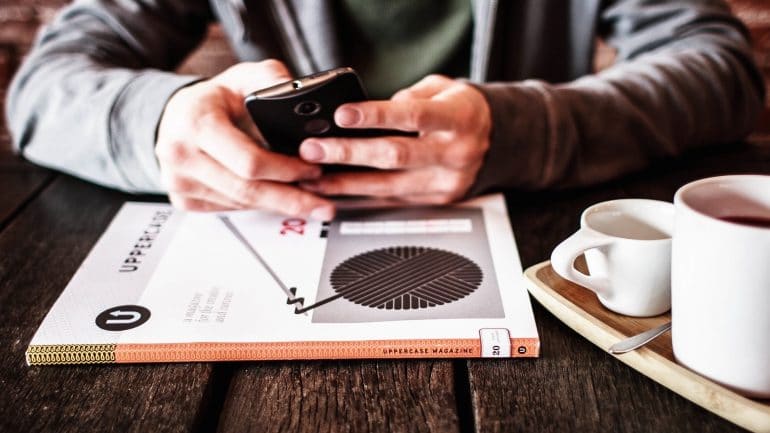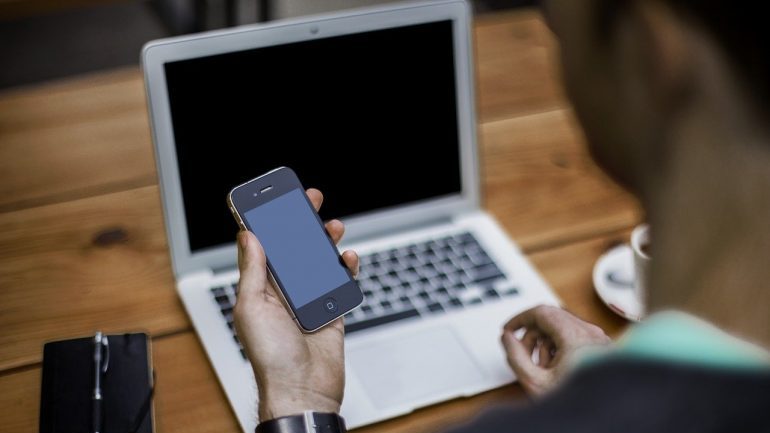30 Surprising Cell Phone Addiction Statistics for 2024
written by / January 15, 2022
Do you ever get nervous or stressed because you forgot to take your phone with you when you left home? Ever promise yourself that you’ll put your cell phone down, yet you find yourself using it anyway? Nomophobia is the official term for smartphone addiction—a rising issue in modern society among both the young and the old.
The following cell phone addiction statistics showcase the varying problems created by the overuse of these devices. Here are some of the most important and most interesting statistics on cell phone addiction. Sit back, relax, and read on to learn all about this issue.
The Top 10 Most Surprising Smartphone Addiction Statistics
- 66.53% of the world’s population has a mobile device.
- People tap, swipe, and click an average of 2,617 times per day.
- iPhone users unlock their phones an average of 80 times per day.
- Users spend an average of 2 hours and 51 minutes a day on their smartphones.
- Residents of the Philippines spend 3 hours and 57 minutes every day browsing social media, according to smartphone usage statistics by country.
- 26% of car accidents are caused by smartphone usage.
- 31% of smartphone users in the US never turn off their phones.
- 52% of American teens want to take steps to cut back on their use of smartphones.
- 45% of American children aged 10–12 have a smartphone.
- 82% of employees put their smartphones where they can see them while working.
General Statistics on Smartphone Addiction

In this section, we’ll be looking at general statistics about addiction to cell phones.
1. 66.53% of the world’s population has a mobile device.
(Statista)
Recent smartphone use statistics showed that more than half of the world’s population owned a device. Research conducted on mobile phone addiction from 2015 to 2019 found that two-thirds of the world’s population owns at least one mobile device. Numerous statistics predict that the number of mobile phone users on a global level will reach 4.68 billion in future years.
2. Currently, 81% of Americans own smartphones.
(Pew Research, ArsTechnica)
For comparison, the smartphone statistics determined in a previous 2013 study show that 56% of adults in the United States had at least one smartphone in their household. This study found another piece of information regarding Americans and cell phone ownership: wealthier citizens have a higher chance of owning a smartphone. However, younger adults with average paychecks are also likely to own one.
3. People tap, swipe, and click an average of 2,617 times per day.
(dscout)
These smartphone usage statistics are shocking. This number includes how often we’re obsessively looking at our phone, tapping and liking, swiping through posts, and clicking on various posts and ads throughout the day.
4. iPhone users unlock their phones an average of 80 times per day.
(Business Insider)
According to analyst Ben Bajarin, iPhones are highly addictive. In addition, it was shown that the average iPhone user checks their phone between six and seven times per hour—or about once every 10 minutes.
5. Cell phone addiction studies show that the average US consumer spends a whopping 5 hours a day on their various mobile devices.
(TechCrunch)
It’s truly shocking how much time American citizens devote to their mobile devices and social media browsing. In addition, American users are spending a large portion of their time (around 51%) browsing through social media, messaging friends and coworkers, and using different applications such as Snapchat.
Important Cell Phone Usage Statistics
These are the most important statistics we have on how people use their smartphones.
6. Users spend an average of 2 hours and 51 minutes a day on their smartphones.
(ComScore)
ComScore’s 2017 Cross-Platform Future in Focus report found that the average adult living in the US spends nearly three hours on their phone every single day. These numbers roughly translate to about 86 hours per month—thus demonstrating the increasing amount of time people spend on their phones.
7. Residents of the Philippines spend 3 hours and 57 minutes every day browsing social media.
(GlobalWebIndex)
According to cell phone use statistics, Youtube, Facebook, and Instagram are taking the world by storm—people from countries from all around the world are getting hooked by the minute. These apps are most easily accessed on mobile devices, and some folks just can’t put them down.
Based on data retrieved by GlobalWebIndex, those in the Philippines come in first place with social media use. Second place belongs to Brazil, whose residents spend 3 hours and 39 minutes on social media. And finally, on the other end of the spectrum, the Japanese come last with a mere 48 minutes of social media time daily.
8. Cell phone addiction statistics found that 71% of smartphone users usually sleep with their device in immediate reach.
(HuffPost)
The statistics found in the Trends in Consumer Mobility Report also hint at some concerning data on smartphones and sleep deprivation. In fact, an incredible stat on nomophobia found that 3% of smartphone users sleep with the device in their hand. It’s no surprise that people are having trouble letting go of their smartphones and are losing sleep as a result.
9. 26% of car accidents are caused by smartphone usage.
(USA Today)
Statistics on cell phone usage found a link between smartphone usage and car accidents. USA Today addressed the National Safety Council’s injury and fatality report—according to which, smartphones cause 26% of car accidents in the United States. It’s estimated that texting is specifically responsible for 5% of the crashes.
10. 75% of users admit that they’ve texted at least once while driving.
(CBS News)
Different cell phone addiction articles have shown that not only can smartphone addiction lead to increased anxiety and irritability, but it can also lead to dangerous behavior. Some studies have also shown that smartphone use while on the road is more dangerous than driving under the influence of alcohol.
11. 31% of smartphone users in the US never turn off their phones.
(Pew Research)
According to the cell phone statistics based on a survey of 3,217 adults by the Pew Research Center, approximately one in three adult smartphone users never turn off their phone, and another 45% rarely turn it off. One of the biggest reasons users refuse to turn off their smartphones is the fear of missing out (in short, FOMO). Many users get anxious thinking about what others might be doing, and they attempt to stay connected all the time.
Teenage Cell Phone Addiction Statistics

Teenagers are often associated with cell phone addiction and here is why.
12. 95% of teens have access to a smartphone.
(Pew Research)
According to a Pew Research Center poll, around 95% of teens have access to a smartphone. The statistics have also found that 54% of teens in the United States spend too much valuable time on their cellphones. This concern has been noted by two-thirds of parents.
13. 45% of teens feel addicted to their smartphone devices.
(Pew Research)
Teenage cell phone addiction is real and should be addressed. Teenage cell phone use statistics showed that around 45% of teenagers constantly check their phones and confess feelings of addiction to their electronic devices. Nevertheless, the increasing trend of social media and technology has suffused teen life—and has proven to be an ongoing struggle not only for teens, but also for their parents.
14. 52% of American teens want to take steps to cut back on their use of smartphones.
(Pew Research)
Pew Research Center also found new facts about cell phone addiction concerning teens’ opinions on the subject matter. Around half of American teens are attempting to cut back on mobile phone use, while also limiting their use of social media, such as Instagram (57%), and video games (58%). This is splendid news, as it shows that teenagers are taking the initiative in reducing their screen time.
15. 56% of American teenagers connect the absence of their smartphones with negative emotions.
(Pew Research)
Statistics conducted by the Pew Research Center have also correlated smartphone addiction and emotional factors. It was found that more than half of American teenagers feel anxious or lonely when they don’t have their smartphone. Plus, teenage cell phone addiction statistics show that girls are more likely to display these unpleasant cell phone addiction symptoms than boys.
16. 57% of American parents attempt to set screen time restrictions for their teens.
(Pew Research)
According to the findings on kids and phone addiction, more than half of American parents are concerned about their teens’ screen time, making screen time limitations one of the most frequent reasons for family conflict.
17. 60% of teens admit that smartphone addiction is a real and serious problem.
(Pew Research)
Of course, not every teen smartphone user admits that using a smartphone is a bad thing. Fortunately, smartphone addiction statistics in the US show that more than half of these teens admit that smartphone addiction is a rising issue in modern society that needs to be faced. Sadly, 40% of teen users still struggle with the fact that cellphone addiction is a rising issue among their generation.
18. Another 60% of teens would rather spend time online with friends than in real life.
(Pew Research)
Shocking cell phone addiction statistics from 2019 claim that around 60% of American teens would rather communicate with friends online rather than socialize in real-life situations. This information might explain why many teenagers feel social anxiety and have trouble making new friends in person. Rather than dismissing this behavior, parents and friends should encourage in-person socializing.
19. The suicide rate for teen girls increased by 65% between 2010 and 2015, coinciding with the rise of smartphone use.
(Science Daily)
The rising trend in cosmetic surgery and false beauty standards set by celebrities like the Kardashians puts significant stress on the young female population. According to cell phone addiction statistics, which investigated data from over 500,000 teens, the connection between increased screen time and depression exists. Teenage girls showed the highest percentage of having suicidal thoughts. This tendency might be explained by the false beauty standards set by society and the fear of missing out.
20. 45% of American children aged 10–12 have a smartphone.
(Nationwide Children’s Hospital)
If you look at cell phone usage statistics by age, you’ll see teenagers and adults aren’t the only age group obsessed with their phones. Recent studies have found that it’s incredibly common that young kids use cell phones.
Adults and Phone Addiction Stats
Of course, teenagers aren’t the only ones who are addicted to their smartphones. The following statistics are all about adults and their cell phones.
21. 85% of smartphone users will check their devices while interacting with friends and family.
(WVLT)
Adults would rather spend time online than directly communicate with friends and family members. Furthermore, various smartphones users statistics show that smartphones may be listed among the top reasons there’s a disconnect in person-to-person relationships. Whether someone displays smartphone addiction symptoms around a partner or family member, it’s evident that an increasing number of smartphone users would rather browse online or take selfies than spend quality time with people.
22. Adults spend on average 58 minutes per day on Facebook, alone.
(Medium)
Cell phone statistics have shown that social media platforms such as Facebook, Instagram, and Snapchat are taking the world by storm, and it’s not just teenagers who are affected by it. After Facebook, the second most commonly used social media platform is Instagram, at around 53 minutes per day.
23. We spend an average of 5 years and 4 months of our lifetimes on social media.
(Mediakix)
For those with an addiction to their smartphone, statistics show that the average smartphone user spends five years and four months on social media platforms such as Youtube, Facebook, Instagram, and Twitter.
Youtube takes the number one spot (around 1 year and 10 months), followed by Facebook (1 year and 7 months). These numbers are quite disturbing when compared to how much time an average person spends on common daily activities. On average, humans spend three years and five months eating and drinking and only six months doing their laundry.
Work and Cell Phone Addiction Stats
How does smartphone addiction affect a person’s work life? We’ll be examining this in the following section.
24. 82% of employees put their smartphones where they can see them while working.
(Career Builder)
Statistics concerning cell phone usage in the workplace found that cellphones are indeed a great disturbance in productivity levels. Many employees check their social media profiles or respond to text messages. Eight in 10 workers (83%) own a smartphone, and around 82% of these individuals keep their smartphones close by, according to the stats and facts about smartphone addiction from 2016.
25. Employees spend around 56 minutes daily using their smartphones for personal business at work.
(Robert Half)
The staffing firm OfficeTeam found that workers spend around 56 minutes per day on their mobile devices while at work. What’s more, workers are using their devices specifically for personal matters in these periods.
26. 62% of managers think their employees spend the majority of their smartphone time during business hours on social networks.
(Robert Half)
When managers were asked about their employees and the increase in cell phone usage, the majority claimed that they’re certain that the staff browses social media networks while at work. However, one of the more interesting facts about an addiction to smartphone use is that 30% of these same workers claim they’re mostly occupied by their personal email during business hours.
27. 33% of female employees check their social networks.
(Robert Half)
Stereotypically, women are more likely to check social media networks than their male counterparts. This tendency is purportedly caused by the different fashion pages, trends, and beauty-related articles women are bombarded with on a daily basis.
According to fairly recent smartphone and social media addiction statistics dealing with women, it was shown that male employees are more likely to check nonwork-related emails on their smartphones (at 32%), while female employees are more likely to browse social media networks such as Facebook and Instagram (at 33%).
28. 68% of male employees use their smartphones to access blocked websites during working hours in the office—compared to 43% of female employees.
(Robert Half)
Furthermore, smartphone use statistics found that male employees are more likely to use their devices to access banned pages and websites while at work. Banned websites mostly include those dealing with pornography, Netflix, Reddit, Tumblr, or Youtube. By banning certain websites during work hours, employers hope to increase productivity levels.
29. Research shows that 28% of the time, employees are likely to make an error at work after taking a phone call, and a mistake is made 23% of the time after texting.
(Forbes, Career Builder, The Straits Times)
Related smartphone addiction statistics in Singapore also show an increasing number of employees addicted to their devices. Residents spend over 12 hours on devices daily. Smartphone addiction kills productivity at work and produces problematic distractions.
30. Taking regular breaks at work increases focus by 30% and creativity by 50%—but not when it involves a smartphone.
(Harvard Business Review)
It is no secret that smartphones are a great danger to productivity at work. Not only does the endless scrolling lead to procrastination at work, but it also kills creativity and focus—and the smartphone addiction stats confirm it. Experts suggest employees take regular breaks at work away from smartphones, as this helps restore the mind and significantly increases productivity levels. Statistics have shown that a break every 90 minutes helps employees focus more and get more creative.
In Conclusion
With the rise of various social media platforms—and with more and more hectic, demanding jobs—it’s not surprising that people from all areas of the world are becoming addicted to their cell phones.
These cell phone addiction statistics up to 2022 show that due to the turbulence of modern-day life, cell phones are here to stay. With this in mind, remember to limit screen time and take a break from electronic devices whenever possible.









